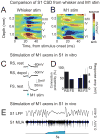Motor cortex feedback influences sensory processing by modulating network state
- PMID: 23850595
- PMCID: PMC3742632
- DOI: 10.1016/j.neuron.2013.06.008
Motor cortex feedback influences sensory processing by modulating network state
Abstract
Long-range corticocortical communication may have important roles in context-dependent sensory processing, yet we know very little about how these pathways influence their target regions. We studied the influence of primary motor cortex activity on primary somatosensory cortex in the mouse whisker system. We show that primary motor and somatosensory cortices undergo coherent, context-dependent changes in network state. Moreover, we show that motor cortex activity can drive changes in somatosensory cortex network state. A series of experiments demonstrate the involvement of the direct corticocortical feedback pathway, providing temporally precise and spatially targeted modulation of network dynamics. Cortically mediated changes in network state significantly impact sensory coding, with activated states increasing the reliability of responses to complex stimuli. By influencing network state, corticocortical communication from motor cortex may ensure that during active exploration the relevant sensory region is primed for enhanced sensory discrimination.
Copyright © 2013 Elsevier Inc. All rights reserved.
Figures








Comment in
-
Top-down control of cortical state.Neuron. 2013 Aug 7;79(3):408-10. doi: 10.1016/j.neuron.2013.07.034. Neuron. 2013. PMID: 23931991 Free PMC article.
Similar articles
-
Distinct Contributions of Whisker Sensory Cortex and Tongue-Jaw Motor Cortex in a Goal-Directed Sensorimotor Transformation.Neuron. 2019 Sep 25;103(6):1034-1043.e5. doi: 10.1016/j.neuron.2019.07.008. Epub 2019 Aug 8. Neuron. 2019. PMID: 31402199 Free PMC article.
-
Motor control by sensory cortex.Science. 2010 Nov 26;330(6008):1240-3. doi: 10.1126/science.1195797. Science. 2010. PMID: 21109671
-
Long-term plasticity in mouse sensorimotor circuits after rhythmic whisker stimulation.J Neurosci. 2009 Apr 22;29(16):5326-35. doi: 10.1523/JNEUROSCI.5965-08.2009. J Neurosci. 2009. PMID: 19386929 Free PMC article.
-
Neocortical dynamics during whisker-based sensory discrimination in head-restrained mice.Neuroscience. 2018 Jan 1;368:57-69. doi: 10.1016/j.neuroscience.2017.09.003. Epub 2017 Sep 14. Neuroscience. 2018. PMID: 28919043 Free PMC article. Review.
-
Cortical control of whisker movement.Annu Rev Neurosci. 2014;37:183-203. doi: 10.1146/annurev-neuro-062012-170344. Epub 2014 May 9. Annu Rev Neurosci. 2014. PMID: 24821429 Review.
Cited by
-
Implications of the Dependence of Neuronal Activity on Neural Network States for the Design of Brain-Machine Interfaces.Front Neurosci. 2016 Apr 20;10:165. doi: 10.3389/fnins.2016.00165. eCollection 2016. Front Neurosci. 2016. PMID: 27147955 Free PMC article.
-
Simulating Cortical Feedback Modulation as Changes in Excitation and Inhibition in a Cortical Circuit Model.eNeuro. 2016 Aug 31;3(4):ENEURO.0208-16.2016. doi: 10.1523/ENEURO.0208-16.2016. eCollection 2016 Jul-Aug. eNeuro. 2016. PMID: 27595137 Free PMC article.
-
Long-range population dynamics of anatomically defined neocortical networks.Elife. 2016 May 24;5:e14679. doi: 10.7554/eLife.14679. Elife. 2016. PMID: 27218452 Free PMC article.
-
Back to Pupillometry: How Cortical Network State Fluctuations Tracked by Pupil Dynamics Could Explain Neural Signal Variability in Human Cognitive Neuroscience.eNeuro. 2017 Dec 26;4(6):ENEURO.0293-16.2017. doi: 10.1523/ENEURO.0293-16.2017. eCollection 2017 Nov-Dec. eNeuro. 2017. PMID: 29379876 Free PMC article. Review.
-
High-order thalamic inputs to primary somatosensory cortex are stronger and longer lasting than cortical inputs.Elife. 2019 Feb 11;8:e44158. doi: 10.7554/eLife.44158. Elife. 2019. PMID: 30741160 Free PMC article.
References
-
- Arieli A, Sterkin A, Grinvald A, Aertsen A. Dynamics of ongoing activity: explanation of the large variability in evoked cortical responses. Science. 1996;273:1868–1871. - PubMed
-
- Berger H. Ueber das Elektroenkephalogramm des Menschen. Arch Psychiatr Nervenkrankh. 1929;87:527–570.
-
- Brecht M. Movement, confusion, and orienting in frontal cortices. Neuron. 2011;72:193–196. - PubMed
-
- Buzsaki G. Rhythms of the brain. New York: Oxford University Press; 2006.
Publication types
MeSH terms
Substances
Grants and funding
LinkOut - more resources
Full Text Sources
Other Literature Sources

